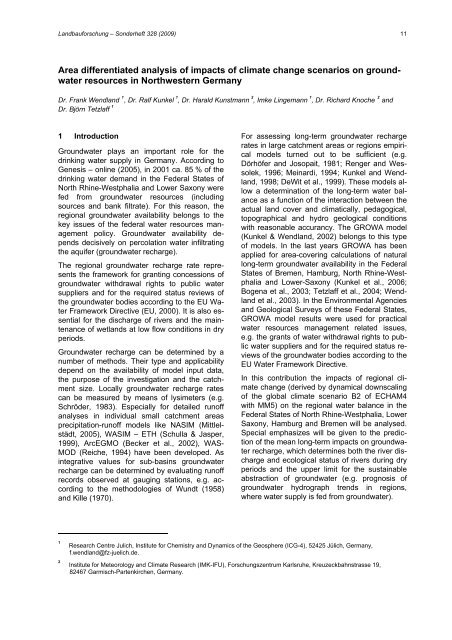Wasser im Gartenbau : Tagungsband zum Statusseminar am 9 ... - vTI
Wasser im Gartenbau : Tagungsband zum Statusseminar am 9 ... - vTI
Wasser im Gartenbau : Tagungsband zum Statusseminar am 9 ... - vTI
Sie wollen auch ein ePaper? Erhöhen Sie die Reichweite Ihrer Titel.
YUMPU macht aus Druck-PDFs automatisch weboptimierte ePaper, die Google liebt.
Landbauforschung – Sonderheft 328 (2009) 11<br />
Area differentiated analysis of <strong>im</strong>pacts of cl<strong>im</strong>ate change scenarios on groundwater<br />
resources in Northwestern Germany<br />
Dr. Frank Wendland 1<br />
, Dr. Ralf Kunkel 1<br />
, Dr. Harald Kunstmann 2<br />
, Imke Lingemann 1<br />
, Dr. Richard Knoche 2<br />
and<br />
Dr. Björn Tetzlaff 1<br />
1 Introduction<br />
Groundwater plays an <strong>im</strong>portant role for the<br />
drinking water supply in Germany. According to<br />
Genesis – online (2005), in 2001 ca. 85 % of the<br />
drinking water demand in the Federal States of<br />
North Rhine-Westphalia and Lower Saxony were<br />
fed from groundwater resources (including<br />
sources and bank filtrate). For this reason, the<br />
regional groundwater availability belongs to the<br />
key issues of the federal water resources management<br />
policy. Groundwater availability depends<br />
decisively on percolation water infiltrating<br />
the aquifer (groundwater recharge).<br />
The regional groundwater recharge rate represents<br />
the fr<strong>am</strong>ework for granting concessions of<br />
groundwater withdrawal rights to public water<br />
suppliers and for the required status reviews of<br />
the groundwater bodies according to the EU Water<br />
Fr<strong>am</strong>ework Directive (EU, 2000). It is also essential<br />
for the discharge of rivers and the maintenance<br />
of wetlands at low flow conditions in dry<br />
periods.<br />
Groundwater recharge can be determined by a<br />
number of methods. Their type and applicability<br />
depend on the availability of model input data,<br />
the purpose of the investigation and the catchment<br />
size. Locally groundwater recharge rates<br />
can be measured by means of lys<strong>im</strong>eters (e.g.<br />
Schröder, 1983). Especially for detailed runoff<br />
analyses in individual small catchment areas<br />
precipitation-runoff models like NASIM (Mittlelstädt,<br />
2005), WASIM – ETH (Schulla & Jasper,<br />
1999), ArcEGMO (Becker et al., 2002), WAS-<br />
MOD (Reiche, 1994) have been developed. As<br />
integrative values for sub-basins groundwater<br />
recharge can be determined by evaluating runoff<br />
records observed at gauging stations, e.g. according<br />
to the methodologies of Wundt (1958)<br />
and Kille (1970).<br />
1<br />
For assessing long-term groundwater recharge<br />
rates in large catchment areas or regions empirical<br />
models turned out to be sufficient (e.g.<br />
Dörhöfer and Josopait, 1981; Renger and Wessolek,<br />
1996; Meinardi, 1994; Kunkel and Wendland,<br />
1998; DeWit et al., 1999). These models allow<br />
a determination of the long-term water balance<br />
as a function of the interaction between the<br />
actual land cover and cl<strong>im</strong>atically, pedagogical,<br />
topographical and hydro geological conditions<br />
with reasonable accurancy. The GROWA model<br />
(Kunkel & Wendland, 2002) belongs to this type<br />
of models. In the last years GROWA has been<br />
applied for area-covering calculations of natural<br />
long-term groundwater availability in the Federal<br />
States of Bremen, H<strong>am</strong>burg, North Rhine-Westphalia<br />
and Lower-Saxony (Kunkel et al., 2006;<br />
Bogena et al., 2003; Tetzlaff et al., 2004; Wendland<br />
et al., 2003). In the Environmental Agencies<br />
and Geological Surveys of these Federal States,<br />
GROWA model results were used for practical<br />
water resources management related issues,<br />
e.g. the grants of water withdrawal rights to public<br />
water suppliers and for the required status reviews<br />
of the groundwater bodies according to the<br />
EU Water Fr<strong>am</strong>ework Directive.<br />
In this contribution the <strong>im</strong>pacts of regional cl<strong>im</strong>ate<br />
change (derived by dyn<strong>am</strong>ical downscaling<br />
of the global cl<strong>im</strong>ate scenario B2 of ECHAM4<br />
with MM5) on the regional water balance in the<br />
Federal States of North Rhine-Westphalia, Lower<br />
Saxony, H<strong>am</strong>burg and Bremen will be analysed.<br />
Special emphasizes will be given to the prediction<br />
of the mean long-term <strong>im</strong>pacts on groundwater<br />
recharge, which determines both the river discharge<br />
and ecological status of rivers during dry<br />
periods and the upper l<strong>im</strong>it for the sustainable<br />
abstraction of groundwater (e.g. prognosis of<br />
groundwater hydrograph trends in regions,<br />
where water supply is fed from groundwater).<br />
Research Centre Julich, Institute for Chemistry and Dyn<strong>am</strong>ics of the Geosphere (ICG-4), 52425 Jülich, Germany,<br />
f.wendland@fz-juelich.de.<br />
2<br />
Institute for Meteorology and Cl<strong>im</strong>ate Research (IMK-IFU), Forschungszentrum Karlsruhe, Kreuzeckbahnstrasse 19,<br />
82467 Garmisch-Partenkirchen, Germany.

















